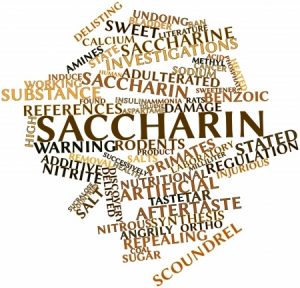
Despite the misleading report from forty years ago that saccharin causes cancer, saccharin remains one of the safer artificial sweeteners in the colored packet line up.
Saccharin never was the cause of cancer in the 1960s safety studies, and the FDA lifted the cancer warning off the pink packets in 2001, one year before Splenda came onto the market.
In the corporate saccharin studies done in the 1960s, saccharin was blended with cyclamate, and the amount of both given to the lab rats was enough to warrant animal abuse. It was determined that the cancer causing agent was the cyclamate.
Needless to say, the studies were shoddy and flawed.
Saccharin
Although saccharin is made exclusively in the laboratory today, its original simplicity may be the key to its ability to be used by the body as a safer chemical sugar substitute.
Compared to the other manmade sugars, saccharin is not as “toxically chemically combined”, and is one of the safer choices for diabetics from the group of manufactured sugar replacements.
Years Of Safe Use
As a kid, I remember my dad always using tiny pellets of saccharin in his morning coffee. Daddy started using saccharin in India during WWII in the 1940s. Saccharin was brought to India from China, where it was made from a root in China. Back then, the amount of saccharin used was very small because it is bitter if you use too much.
Big Corps can’t make lots of money off tiny pellets, you know.
Monsanto

Does it surprise anyone that Monsanto is behind saccharin’s history?
In 1902, Monsanto gained its reputation manufacturing saccharin, the company’s first product. In 1903 to 1905, their entire saccharin output was shipped to the growing soft drink company in Georgia called Coca-Cola®.
In 1917, the U.S. government filed suit over the safety of saccharin. Filed at Monsanto’s request as a test case, the suit was dismissed in 1925, ending the government’s unsuccessful attempts to prove saccharin as harmful.
In 1981, saccharin was again questioned as a carcinogen, but no conclusive scientific proof was ever presented. In 2001, the cancer warning was removed from saccharin products as saccharin was shown, once again, to be safe for human consumption.
Actually, it never really mattered to Monsanto if you picked the pink or blue packet because Monsanto Chemical Company owned both products (saccharin and aspartame) for over twenty years. Blue or pink – they won your dollar.
In the year 2000, they sold their sweetener division for $440 million, just in time for the competitor’s yellow packet of Splenda to join the sweetener market.
So, Is Saccharin Safe To Use?
I don’t advocate using any of the artificial sweeteners, but based on the history and the research – saccharin is your safest bet when choosing a colored sweetener packet placed on your dining table. Especially for diabetics.
Saccharin has never done harm to people like the blue, yellow, or white packets.
Hum, I wonder if it’s still used in the bottled Coca Colas?
_______________
If you want to learn more about healthy living and disease prevention, contact me at janethull.com. Remember that you are never alone when you are looking for good health!
I look forward to supporting you on your journey to alternative health and wellness.
_____________
Disclaimer: This article is for informational purposes only, and is educational in nature. The FDA may not have evaluated some of the statements. This article is not intended to diagnose, treat, cure, or prevent any disease. Please discuss with your own, qualified health care provider before adding supplements or making any changes to your dietary program.
Before taking vitamins, consult your doctor; pre-existing medical conditions or medications you are taking can affect how your body responds to multivitamins.
You have our permission to reprint this article if you attribute us with a live back-link to this article and the youtube links. http://www.janethull.com/
_______________
[…] Saccharin sales increased, reappearing in more food products. […]